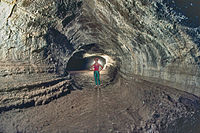
Photo from wikipedia
Abstract Mounting evidence from the SELENE, LRO, and GRAIL spacecraft suggests the presence of vacant lava tubes under the surface of the Moon. GRAIL evidence, in particular, suggests that some… Click to show full abstract
Abstract Mounting evidence from the SELENE, LRO, and GRAIL spacecraft suggests the presence of vacant lava tubes under the surface of the Moon. GRAIL evidence, in particular, suggests that some may be more than a kilometer in width. Such large sublunarean structures would be of great benefit to future human exploration of the Moon, providing shelter from the harsh environment at the surface—but could empty lava tubes of this size be stable under lunar conditions? And what is the largest size at which they could remain structurally sound? We address these questions by creating elasto-plastic finite element models of lava tubes using the Abaqus modeling software and examining where there is local material failure in the tube's roof. We assess the strength of the rock body using the Geological Strength Index method with values appropriate to the Moon, assign it a basaltic density derived from a modern re-analysis of lunar samples, and assume a 3:1 width-to-height ratio for the lava tube. Our results show that the stability of a lava tube depends on its width, its roof thickness, and whether the rock comprising the structure begins in a lithostatic or Poisson stress state. With a roof 2 m thick, lava tubes a kilometer or more in width can remain stable, supporting inferences from GRAIL observations. The theoretical maximum size of a lunar lava tube depends on a variety of factors, but given sufficient burial depth (500 m) and an initial lithostatic stress state, our results show that lava tubes up to 5 km wide may be able to remain structurally stable.
Journal Title: Icarus
Year Published: 2017
Link to full text (if available)
Share on Social Media: Sign Up to like & get
recommendations!